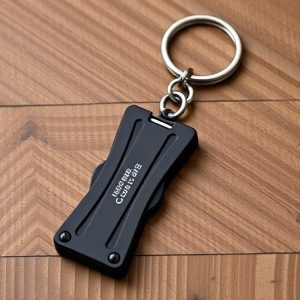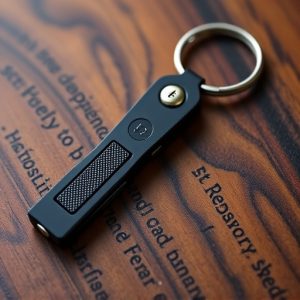Keychain Safety Devices: Legal Checklist for Women’s Security
Concealed keychain protection devices designed for women's safety have gained popularity as inn…….
Concealed keychain protection devices designed for women's safety have gained popularity as innovative self-defense tools, but their legality varies greatly by location. Users and manufacturers must thoroughly research local laws to ensure compliance, with regulations governing permit requirements, age restrictions, training, and the type of force deployed. In the U.S., state-specific laws significantly influence accessibility and use, emphasizing responsible usage as a last resort for personal safety. Staying informed about legal updates is crucial for both users and manufacturers to enhance personal safety without compromise.
In today’s world, personal safety is paramount, especially for women who often face unique risks. One innovative solution gaining traction is the concealed keychain protection device. This article delves into the legal landscape surrounding these compact self-defense tools, focusing on their role in enhancing women’s safety. We explore state-by-state regulations, examine rights and restrictions, and provide guidance for manufacturers and users to ensure compliance with the ever-evolving legal requirements for concealed keychain protection devices.
- Understanding Concealed Keychain Protection Devices: A Legal Perspective
- Targeting Women's Safety: Regulations and Rights
- Key State-by-State Legal Requirements for Concealed Keychains
- Ensuring Compliance: Tips for Manufacturers and Users
Understanding Concealed Keychain Protection Devices: A Legal Perspective
Concealed keychain protection devices, designed for women’s safety, have gained significant traction as innovative solutions to carry and protect keys discreetly. These devices offer a unique approach to personal security, especially in situations where open-carry weapons are not feasible or desirable. From a legal standpoint, understanding the regulations surrounding these tools is essential for users and manufacturers alike.
In many jurisdictions, concealed keychain protection devices fall under specific laws governing the carry of defensive tools or self-defense items. Regulations can vary widely based on location, with some regions having stringent requirements on the type, size, and purpose of such devices. For women considering these tools, it’s crucial to research local laws to ensure compliance, especially when traveling between states with differing regulations. Manufacturers must also adhere to these legal parameters to avoid potential legal repercussions.
Targeting Women's Safety: Regulations and Rights
In recent years, there has been a growing recognition of the unique safety challenges faced by women, leading to an increased focus on developing and implementing concealed keychain protection devices. These innovative tools aim to empower women with quick and discreet self-defense options, addressing the pressing issue of gender-based violence and assault. Many countries have taken notice, introducing legal frameworks that support and regulate the use of such devices to enhance women’s safety without infringing upon their rights.
Regulations surrounding concealed keychain protection devices for women vary from region to region. Some jurisdictions require users to obtain permits or licenses for carrying such devices, while others may have specific age restrictions or mandate training in their proper use. These legal requirements ensure that the right to self-defense is balanced with public safety concerns. Moreover, laws often emphasize the device’s purpose as a last resort for personal protection, underscoring the importance of promoting peaceful resolution over aggressive responses.
Key State-by-State Legal Requirements for Concealed Keychains
In the United States, the legal landscape surrounding concealed keychain protection devices varies significantly from state to state, impacting their accessibility and use, particularly for women seeking enhanced personal safety. Understanding these state-specific regulations is crucial for anyone considering carrying a concealed keychain for self-defense. Some states have specific laws regarding hidden weapons, including keychains with defensive capabilities. These laws dictate issues like permit requirements, allowed locations, and the types of devices that are legal to possess.
For women who prioritize personal safety, it’s essential to know that certain states have more liberal regulations, allowing for concealed keychain protection without a permit in public places. However, other states may require permits or limit their use to specific scenarios, such as self-defense within one’s residence. Keychain devices designed for protection must also meet specific criteria, including safety features and restrictions on the type of force they can deploy, ensuring responsible and legal usage.
Ensuring Compliance: Tips for Manufacturers and Users
Ensuring compliance with legal requirements is paramount for manufacturers and users of concealed keychain protection devices designed for women’s safety. Key factors include meeting specific safety standards, such as those related to materials used, product durability, and functionality under stress. Manufacturers should conduct thorough research on local and international regulations, ensuring their products comply with relevant safety guidelines, particularly in regions with stringent consumer protection laws.
For users, it’s crucial to select keychain devices that bear certifications from reputable testing agencies. Verifying the legitimacy of these certifications ensures the product has undergone rigorous testing for both effectiveness and user-friendliness. Additionally, staying informed about updates to legal requirements can help women make informed choices when purchasing concealed keychain protection devices, enhancing their personal safety without compromise.
In light of the growing need for personalized safety solutions, understanding the legal landscape surrounding concealed keychain protection devices is paramount. This article has explored the unique considerations for these innovative tools, with a specific focus on women’s safety. By delving into state-by-state regulations and offering compliance tips, we aim to empower both manufacturers and users to navigate this space effectively. Ensuring that such devices not only enhance personal security but also adhere to legal requirements is crucial, especially in promoting a safer environment for all, particularly women who often face unique safety challenges.


